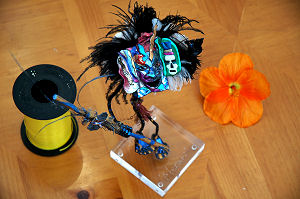Conventional wisdom says that prime (non-zoom) lenses are the highest quality lenses money can buy. But that wisdom is being challenged by high quality zoom lenses that match or even rival the sharpness and contrast of the best primes. Make no mistake, the best zoom lenses aren’t cheap or small. But the convenience afforded by a zoom lens, even an inexpensive one, to crop with a twist of the wrist or the touch of a button is hard to resist.
The ubiquity of the zoom on compact cameras and as part of SLR kits may have led some to believe that zooming in on a subject is the same as getting physically closer. But there is a big difference between zooming with your lens and “zooming” with your feet.
Film and digital sensors are, for practical purposes, two-dimensional. After looking at photographs for a while, it’s easy to forget that the world they were photographed in is three-dimensional with depth, spatial relationships between objects, and perspective. When you look at a print or an image on a computer screen and move it closer or farther from you, you don’t change any of the relationships between the objects in the photo.
That is, they all get larger or they all get smaller by the same degree. They don’t appear to shift position relative to one another. This is the same effect you get when you use a zoom lens. When you stand in one place and change from a shorter to a longer focal length (zoom in), you are just taking the scene and enlarging and cropping it.

Merari at 70mm and 18mm. 1/60s @ f/4.5
Move your mouse over the photo to see the same composition at 18mm.
None of the objects were moved between shots. Notice in the 18mm shot,
where the camera was much closer, how the stick seems to poke out of
the scene, the two background objects seem to move further into
the background, and lines are converging. The 70mm shot was taken from
farther away and has a more flattened perspective and straight lines.
The zoom was used to get the same composition as moving closer but
it just doesn’t give us the same look.
This is in marked contrast to actually moving closer to your subject. When you “zoom with your feet” you are moving through a three-dimensional space. The apparent position of objects around you shifts. Their positions and sizes change relative to other objects in the scene. The distance between closer and more distant objects and objects near the edges of the frame becomes exaggerated. Lines in the scene appear to converge or diverge.
As you move even closer, subjects in the center of the frame seem to bulge towards the camera while edge objects recede into the background. In this sense, moving closer or farther away from a subject is a much more dynamic action than simply turning the zoom ring. And the effect can be subtle or it can be quite extreme as seen in closeups shot with super wide-angle lenses.

Girl, closeup. 1/125s @ f/3.5, 18mm.
Notice the distorted perspective created by
moving the lens very close to the subject.
This technique has practical applications (imagine you’re about to shoot a portrait and notice a background tree appearing to sprout from a friend’s head — zooming in won’t eliminate the tree but moving closer can) and it can also be used to create different creative compositions that aren’t possible by simply turning your zoom ring.
Not to mention that moving around in the scene you are photographing, seeing it from different angles, will allow you to see new opportunities that you might have missed if you just stood in one spot.
Let me know your thoughts.









Great article, I’ve always sort of known/thought this, but you really explained it and helped me understand it more!
I’m gonna try this the next time I’m out photographing. Nice article.